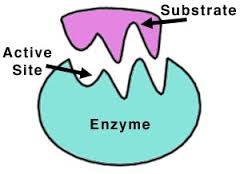I think you are referring to enzymes which are complex proteins produced by all living things.
By acting as catalysts (which are chemical substances which can change the rate of a chemical reaction without being affected themselves by that reaction), they play a very important part in almost all the chemical reactions that take place in organisms.

Enzymes consist of chains of amino acids linked together and each kind of enzyme has a characteristic arrangement. The bonds in the chain are weak and can be broken by high levels of acids or high temperatures. In this case, the enzymes cease to function and that is when disease can occur.
Here is an example:
A substrate molecule (starch possibly) is ready to be broken apart in a living body. A large amount of energy is needed to do this, larger than is available in the body. The substrate remains in its complete form.
An enzyme with the correct molecular shape (remember these differ according to type) arrives and attaches itself to the substrate molecule.
Chemical bonds will then form between the substrate and enzyme molecules. These bonds cause the bonds within the substrate molecule to become weaker and these bonds may break causing the substrate molecule to split into two.
It is not long before the bonds between the substrate and the enzyme molecules break and the two parts move away from each other. By this time, the substrate molecule has also broken apart.
The enzyme has enabled the breakdown of the substrate without the addition of much energy. The products of this reaction can now move freely, and the enzyme can now find another substrate molecule of the same kind and repeat the process.